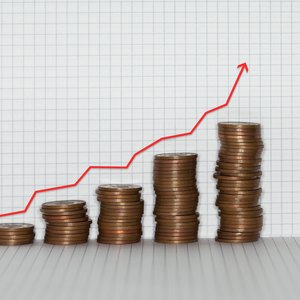
Inflation is defined as a rise in an economy’s general price level across a variety of sectors, including housing, energy and food. Historically, the U.S. inflation rate has averaged 3 percent annually. From 1917 to 1920, in 1942, and in the late 1970s, however, it rose above 10 percent. Russia and some Latin American countries are among those with historically high inflation rates. A negative inflation rate is called deflation.
Tips
Various factors can affect the inflation rate, including the amount of money currently in circulation as well as national production levels and consumer demand.
Exploring the Money Supply
Central banks can control interest rates by increasing or decreasing the money supply. Increasing the amount of currency in circulation causes interest rates to fall. When the growth of the money supply outpaces the growth in the economy, however, inflation rises. Since the major currencies moved away from the gold standard in the last century, the value of a currency is a function of its supply and demand in the global market. Increasing the supply of a currency faster than the country’s economy floods the market with supply that decreases its relative value. Inflation is the result of this devaluation.
Assessing National Debt
Over the long run, continually increasing a country's national debt will lead to increasing inflation. Any strategy a country takes to combat a rising national debt can ultimately lead to higher inflation. The first strategy for decreasing the national debt is to increase tax revenue. Corporations must earn money for shareholders, so they are likely to respond to higher tax rates by raising prices on their goods and services. Higher priced goods and services result in higher inflation. The second strategy for decreasing the national debt is to increase the money supply, using this money to pay off the existing debt, but this can also lead to inflation as the higher supply of money makes each individual unit of currency worth less.
Defining the Cost-Push Effect
Increasing the cost of one production component causes the price of the finished good to increase as well. When the price of coffee beans increases, the price of lattes at the local coffee shop also increase. When the price of oil increases, transportation costs for all goods rise. Those increasing transportation costs pass through to the retail price of all goods. So, increases in the cost of raw materials ultimately lead to increases in the inflation rate, as manufacturers at various levels of supply chains pass costs on to their customers, and ultimately to individual consumers.
Evaluating the Demand-Pull Effect
In a strong, healthy economy, wage rates and household wealth increase. When people have more money in their pockets, they can spend more on goods and services. Holding supply steady while increasing the demand for goods and services results in increased prices, since people are effectively bidding agains each other for the limited supply of goods, whether they're houses or hamburgers. Strong demand without an increase in supply results in higher prices and a higher inflation rate.
References
- Inflation Data: Historical Inflation Rate
- Causes of Inflation - Economics Help
- Money Crashers: What Is Inflation Definition – Causes of Inflation Rate and How to Fight the Effects
- Bureau of Labor Statistics. "Consumer Price Index: Overview." Accessed Oct. 1, 2019.
- Bureau of Labor Statistics. "Producer Price Indexes." Accessed Oct. 1, 2019.
- Inflation Data. "Historical Consumer Price Index (CPI-U) Data." Accessed Dec. 4, 2019.
- Federal Reserve History. "The Great Recession and its Aftermath." Accessed Oct. 1, 2019.
- Federal Reserve. "Federal Reserve issues FOMC statement of longer-run goals and policy strategy." Accessed Oct. 1, 2019.
- European Central Bank. "How quantitative easing works." Accessed Oct. 1, 2019.
- Reserve Bank of India. "Monetary Policy." Accessed Oct. 1, 2019.
- Central Bank of Brazil. "Inflation targeting track record." Accessed Dec. 4, 2019.
- Bureau of Labor Statistics. "Consumer Price Index – October 2019," Page 20 Accessed Dec. 4, 2019.
Writer Bio
Kimberly Goodwin has a Ph.D. in finance from the University of Alabama and is an associate professor of finance and the Parham Bridges Chair of Real Estate at the University of Southern Mississippi. She publishes in top real estate journals as well as on her blog, Your Finance Professor. Goodwin is also the managing editor of the Journal of Housing Research.

